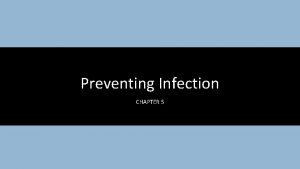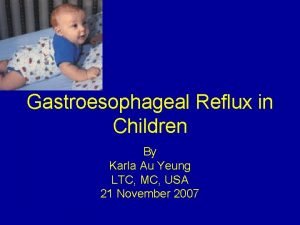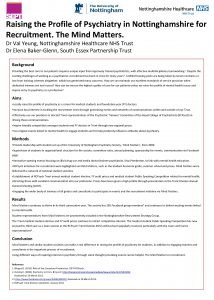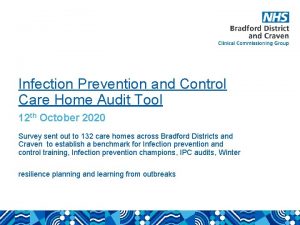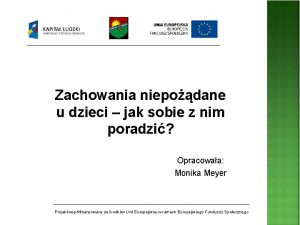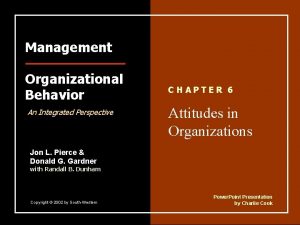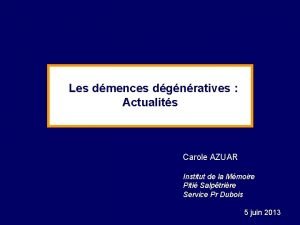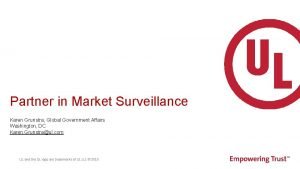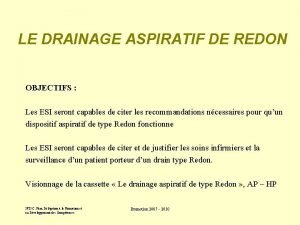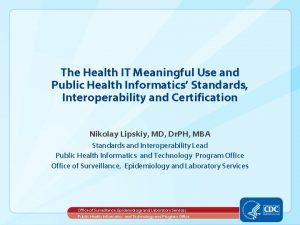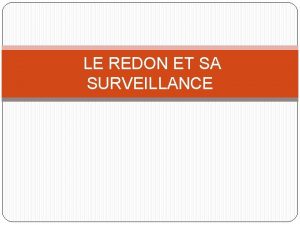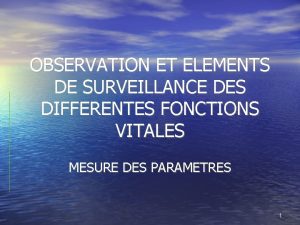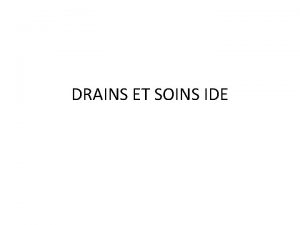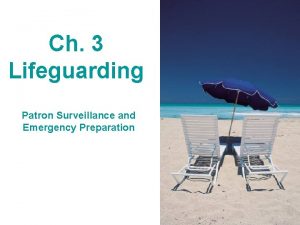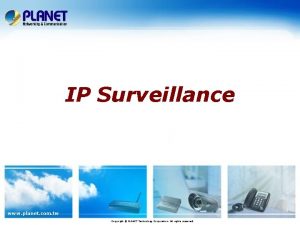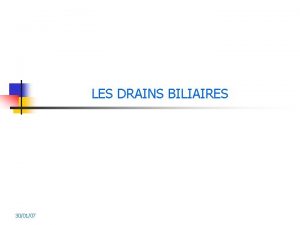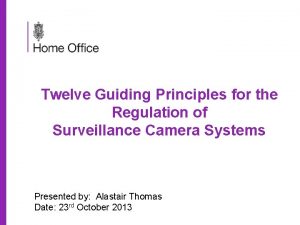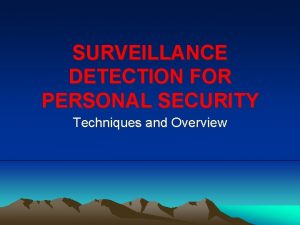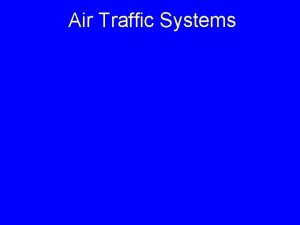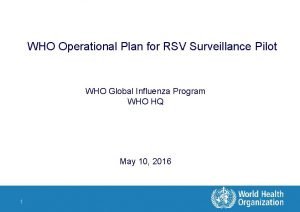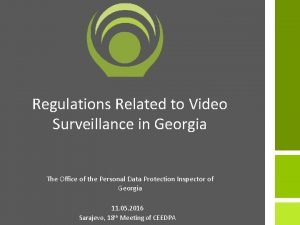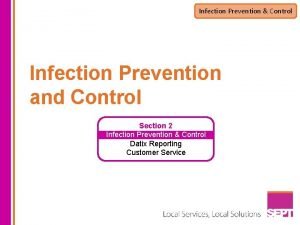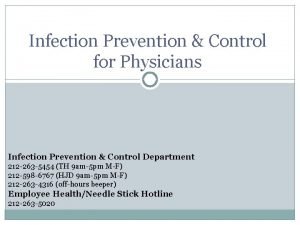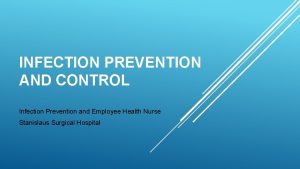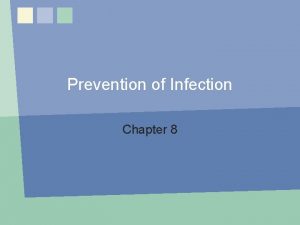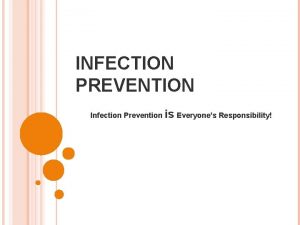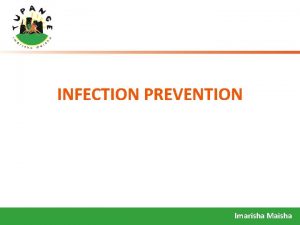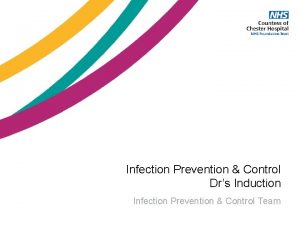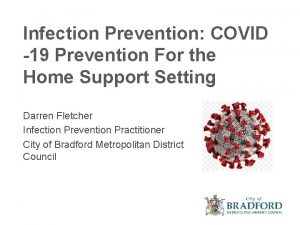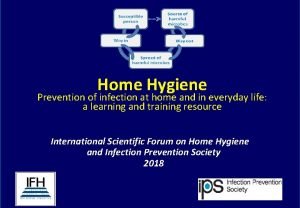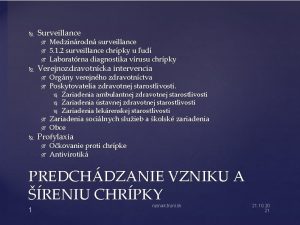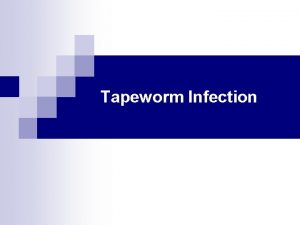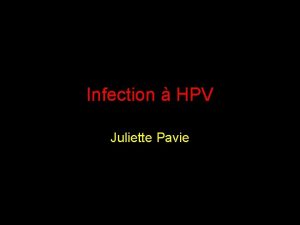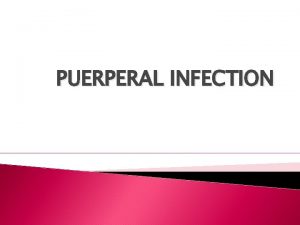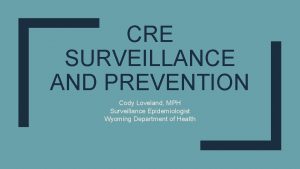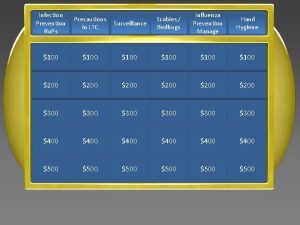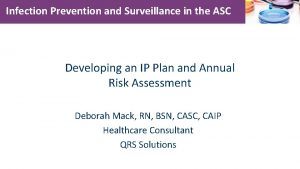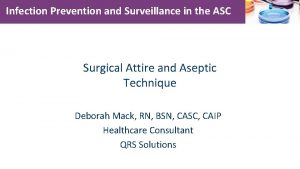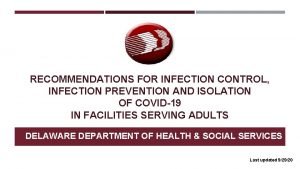Infection Prevention Surveillance in Home Carole Yeung RN


























































- Slides: 58

Infection Prevention Surveillance in Home Carole Yeung, RN CIC Nothing to disclose

Outline � Surveillance (in general) � HAI Surveillance � Practical Application ◦ CAUTI Reduction

Objectives: � Discuss methods for identifying potential infections using OASIS and applying the APICHICPAC Surveillance Definitions for HHC and Home Hospice Infections � Describe the use of surveillance to improve outcome and process measures � Analyze and report findings of the surveillance data including the development of action plans

CMS – Condition of Participation Hospice Agencies � The hospice must maintain and document an effective infection control program that protects patients, families and hospice personnel by preventing and controlling infections and communicable diseases �A plan for the appropriate actions that are expected to result in improvement and disease prevention

CMS – Condition of Participation Home Health Agencies � Current: ◦ No requirement for agency wide program ◦ Must comply with accepted professional standards & principles that include infection prevention

CMS – Condition of Participation Home Health Agencies � Proposed: ◦ Maintain and document a program to prevent and control infections & communicable disease ◦ Follow accepted standards, including standard precautions, and educate staff, patients, and caregivers about proper infection control procedures

Surveillance � Surveillance is defined as “the ongoing, systematic collection, analysis, interpretation and evaluation of health data closely integrated with the timely dissemination of this data to those who need it”. (Centers for Disease Control and Prevention. CDC surveillance update. Atlanta: Centers for Disease Control and Prevention, 1988)

Surveillance is: � Essential component of an infection prevention & control program to reduce frequency of adverse events � Comprehensive method of measuring outcomes and other processes of care � Systematic methods of collecting, consolidating and analyzing data concerning distribution & determinants of a given disease or event � Dissemination of information to those who can improve outcomes � Outbreak investigation/Performance Improvement

Surveillance Program Design � No “single” or right method � Based on population served , services provided, & regulatory or other requirements (Infection Prevention Risk Assessment) � Requires direct involvement of organization leaders � Team work and collaboration across the healthcare spectrum are important in the development of surveillance plans � Designed in accordance with current recommended practices and defined elements � Incorporate into Safety & PI Programs

Surveillance � Written plan serves as the foundation and should outline important objectives and elements: ◦ HAI ◦ Non HAI (community) ◦ Non infectious disease events

Infection Prevention Risk Assessment � Multidisciplinary team � Identify areas of risk and potential impact on patients, staff, and agency. � Identify risks based on: ◦ Geographic location, community, and population served ◦ Care, treatment, or services provided � Evaluate each potential risk in each of the three categories of probability, impact, and current systems.

http: //www. apicdfw. org/seminar/2008/lee 1. pdf Terrie Lee adapted for BHHHN

Choosing indicators to monitor � Measure outcomes and processes � Monitor a variety of outcomes/processes � Monitor high-risk/high-volume events � Cost/negative impact � Mandates to monitor specific indicators � Determine time period for observation

Outcome Measures � CLABSI (Central line associated blood stream infections) � CAUTI (Catheter associated urinary tract infections) � Skin and soft tissue infections � Flu vaccination rates (patients and hcw) � Sharp injuries in HCW � Include community (if applicable)

Process Measures � Adherence to published standards/best practices (hand hygiene, infectious disease precautions) � Training and competence of care provided by family/care givers � Evaluation of specific infection prevention and control measures (home care bag checks) � Best practices for invasive device infection prevention

Outcome and Process Measures � Outcome: ◦ Catheter Associated Urinary Tract Infection Reduction by 10% � Process: ◦ Assure best practices are being followed for care of a patient with an indwelling catheter

Develop a Plan � Goals (broad statements) � Objectives (specific and measurable) � Strategies (steps to take to achieve goals) � Evaluation (how you will measure your achievement of objectives) � Progress (current measure and next steps)

Surveillance Definitions � Standard definitions to ensure precise surveillance (preferably published) � Definitions should be consistently used in the collection, analysis, and reporting of surveillance data

Determine Methods for Collecting Data � When to collect data? ◦ Concurrent ◦ Retrospective � Who will collect the data? � Where to find data? � How to collect data?

Where to Find Data? � Unique to the organization � Specific to surveillance plan � Learn from colleagues, reports in the literature � Collect data from a variety of sources ◦ ◦ ◦ Clinicians OASIS Data Medical Records (paper, electronic) Lab reports Direct Observation

How to Collection Data? � Data Collection Form ◦ Identify data elements to be collected ◦ Limit data collection to elements that are needed to identify a case or determine the case criteria are met for condition or event being studied

Compilation of Surveillance Data � Data must be analyzed, interpreted, and reported � Expressed in numerical measurement of the outcome/process observed � Essential that appropriate calculations be performed and reported with a consistency of methodology over time for interpretation of each surveillance component � Data can be non useful if numerator too small or denominator of inappropriate size

Interpretation of Surveillance Data � Rates accurately calculated? � Major changes from previous data � Substantially high rates ◦ May signify a problem ◦ Investigate risk factors/processes ◦ No obvious observation

Reporting the data � Design a report ◦ Tables, graphs, charts, and summary graph ◦ Disseminate to managers and healthcare providers who can use the findings to improve performance ◦ Healthcare workers ◦ Supervisors/Managers � Federal, state, and local authorities � Referring � Systemic or receiving facilities ongoing process

HAI Surveillance � Goals: ◦ Enhance safety and quality of patient care ◦ Reductions in: �Morbidity and mortality �Emergent care �Acute care hospitalizations �Cost

HAI Surveillance � Purpose: ◦ Assess the safety and quality of patient care by establishing a baseline and monitoring trends ◦ Use findings to improve care to prevent infections and other complications ◦ Detect & investigate clusters or outbreaks (including community) ◦ Assess effectiveness of prevention & control measures ◦ Ensure regulatory compliance

HAI Surveillance � Do not routinely include identification of community-acquired infections � Report infections to other facilities � May be useful to: ◦ Know patients with MDRO’s in the agency and notify patient infectious status to another agency/facility if patient is transferred ◦ Assure appropriate precautions

Temporal Association � Describing an infection to the agency does not mean that they caused it. The following can increase the risk of infection: ◦ Certain conditions or therapies place pts at increased risk ◦ Other elements not directly associated with a persons healthcare status can increase the risk ◦ Environmental factors ◦ Agent factor

HAI Surveillance � Not intended to be used to make clinical decisions or to determine treatment � Consultation beneficial with hospital IP may be � APIC-HICPAC Surveillance Definitions for Home Health Care & Home Hospice Infections, 2008 � Surveillance Form


Data Collection � Clinicians reporting � Case Conferences � Local hospitals � Networking with local IP’s � OASIS data • Designated person to review the evidence to determine if definition for HAI is met

Data Collection - OASIS � M 2300. Since last time OASIS data collected has the patient utilized the Emergency Department: q 0 No q 1 Yes, use hospital ED without hospital admit q 2 Yes, use hospital ED with hospital admit q. UK � M 2310 Reason for Emergent Care

Data Collection - OASIS � Time Point M 2300 & M 2310: ◦ Transfer to inpatient facility, with or without agency discharge ◦ Discharge from agency

Data Collection - OASIS � M 2430 � Time Reason for Hospitalization Point: ◦ Transfer to inpatient facility, with or without agency discharge

DATA Collection - OASIS � M 2310 and M 2430 q 3 – Respiratory Infection q 13 – UTI q 14 – IV catheter-related infection or complication q 15 – Wound infection/deterioration

DATA Collection - OASIS � M 1600: has this patient been treated for a UTI in last 14 days q 0 - No q 1 - Yes q. NA - Patient on prophylactic antibiotics q. UK – Unknown � Time Points: ◦ SOC/ROC ◦ DC from the agency – not to inpatient facility

Benchmarking �Internal: ◦ agency historical data �External: ◦ Must use same case findings ◦ Must use same case definitions

CAUTI Reduction � IPRA – CAUTI � 2009 rate: 0. 9 CAUTI/1, 000 catheter days

CAUTI Reduction � Goal: Reduce CAUTI in patients with indwelling catheters � Objective: Reduce CAUTI by 20% next 2 years. (Decrease antibiotic use. Decrease MDRO acquisitions) � Improvement strategies: ◦ Review the literature – best practices ◦ Update procedures as necessary ◦ Monitor patients with indwelling catheter during supervisor visits including hand hygiene ◦ Education – all disciplines � Evaluation/Progress: Quarterly report to Administration Team and healthcare workers

Definition of CAUTI � Must meet one of the following criteria and had an indwelling catheter within the last 7 days: 1. Two of the following signs/symptoms: ◦ ◦ Fever or chills Flank pain, suprapubic pain, tenderness, frequency, urgency Worsening mental/functional status Changes in urine character AND urinalysis or culture not done 2. One of the following two signs or symptoms: ◦ Fever or chills ◦ Flank pain, suprapubic pain, tenderness, frequency, urgency AND ◦ Bacteria (positive culture or nitrite)and pyuria (>10 wbc/hpf or leukocytes) on urinalysis (APIC-HICPAC Surveillance Definitions for Home Health Care and Home Hospice Infections, 2008)

Limits of the definitions � Potential for subjectivity: 48 hrs vs 72 hrs after admission to HC Changes in urine character? What constitutes a potential pathogen? Colony count? Why is worsening of mental or functional status not included in criteria 2? ◦ Why 7 days after catheter discontinued? ◦ ◦ ◦ � Need for more “concrete” criteria if HHC

Data Collection � Clinicians � Case Conferences � OASIS q reporting data M 2310 and M 2430 13 – UTI � OASIS data M 1600 (treatment of a UTI in the last 14 days)

Source: BHHHN - LR 43

Line Listing

Denominator � Indwelling urinary catheter days vs patient days (do not include suprapubic) ◦ Clinicians reporting ◦ Computer profiles �Clinicians document �Develop a report (may need IT help)

Calculate rate 6 CAUTI 2, 132 Catheter Days X 1, 000 = 2. 8 CAUTI/1, 000 catheter days

Best Practice � Sterile technique for insertion � Consider using smallest bore catheter as possible (14– 16 fr with a 5 cc balloon) � Discourage irrigation � Urinary Catheter Maintenance � Patient/caregiver education � S/S infection � Specimen collection/transportation � Catheter removal

Care of Catheter in a Patient � Develop � Assess check sheet care when perform home visits: ◦ Skilled nurses ◦ Supervisory Visits ◦ AIDES

Care of the catheter Catheter connected to closed drainage system Urinary catheter is secure to prevent movement Drainage bag below level of the bladder Family has education sheet Compliant Non Compliant N/A

Monitor Hand Hygiene 1 Hand hygiene before patient contact or putting on gloves Hand hygiene after patient contact or removing gloves Hand hygiene before reaching into home care bag 2 3 4 5 6 7 Total %

Education � Formal – Education days ◦ SN ◦ Therapy and AIDES � Informal – Case conferences

CAUTI 2010 - 2011 Best Practices 1. 2 Supervisor check list 1 0. 8 Education 0. 6 0. 4 0. 2 0 Ja n M ar M ay Jul Se p N ov

CAUTI 2009 - 2011 1. 2 1 Total 58% 0. 9 0. 8 0. 57 0. 6 0. 38 0. 4 ↓ 36% ↓ 33% 0. 2 0 2009 2010 2011

Outcomes � CAUTI rate for 2011 is 0. 38/1, 000 indwelling catheter days. A reduction of 58% compared to 2009. � Procedure updated. Removed standing orders for irrigating a catheter � Developed a UTI Prevention CBL for SN and for Therapy and Aides � Patient care giver education sheet � Care of patient with indwelling catheter resulted in > 90% compliance � Education completed by 98% (141/144) clinicians

Interpret the Data – Food for Thought � Reported infections do not meet the criteria but being treated. Over culturing that may lead to antibiotic resistance � Specimen collected inappropriately – clinical UTI but culture contaminated � Most patients with catheters have bacteria if left in >30 days

References for Best Practices � APIC: Guide to Elimination of CAUTI, 2008 � HICPAC/CDC: Guideline for Prevention of Catheter Associated � Best Practice for Indwelling Catheter in the Home Care Setting. � Catheter Management in a Home Care Setting. � Urinary Tract Infections, 2009 HHN vol. 22, no 12, Dec 2004 Caring, April 2009 The Quest for Best Practice in Caring for the HC Patient with an Indwelling Urinary Catheter: The New Jersey Experience. HHN vol. 25, No 2, Feb. 2008 � Rhinehart E. , & Mc. Goldrick , M. (2006). Infection Control in Home Care and Hospice. Sudbury MA. Jones and Bartlett.

And in Closing…. � Good surveillance does not necessarily ensure the making of right decisions, but it reduces the chances of wrong ones” Alexander Langmuir

Questions? Carole. Yeung@baptist-health. org
 Primary prevention secondary prevention tertiary prevention
Primary prevention secondary prevention tertiary prevention Chapter 16 infection prevention and control
Chapter 16 infection prevention and control Puncture resistant container
Puncture resistant container Define infection prevention chapter 5
Define infection prevention chapter 5 Chapter 19 disease transmission and infection prevention
Chapter 19 disease transmission and infection prevention Chapter 19 disease transmission and infection prevention
Chapter 19 disease transmission and infection prevention Karla au yeung
Karla au yeung Ivan yeung
Ivan yeung Dr val yeung
Dr val yeung Yeung
Yeung Dr jean chuo
Dr jean chuo Infection controlcare home
Infection controlcare home Carole goble
Carole goble Carole osborne sheets
Carole osborne sheets What is equality
What is equality Metoda carol sutton
Metoda carol sutton Carole letrouit
Carole letrouit Carole delporte
Carole delporte Carole marni
Carole marni Carole bucy
Carole bucy War photographer analysis
War photographer analysis Carole bouquet
Carole bouquet Carole azuar
Carole azuar Carole epee
Carole epee Carole fullerton math books
Carole fullerton math books Carole goble
Carole goble Marieamlie
Marieamlie Carole garcin
Carole garcin Carole letrouit
Carole letrouit Carole twining
Carole twining Let's go to your house
Let's go to your house Plural of flower
Plural of flower Arman home sweet home
Arman home sweet home Apa arti dari home care
Apa arti dari home care Softly and tenderly jesus is calling
Softly and tenderly jesus is calling She said that, home economics stands for the ideal home.
She said that, home economics stands for the ideal home. Perbedaan home care dan home visit
Perbedaan home care dan home visit Oak springs mobile home park
Oak springs mobile home park Home sweet home survive prayer
Home sweet home survive prayer South carolina mobile home parks for sale
South carolina mobile home parks for sale Ul market surveillance
Ul market surveillance Manovac drainage
Manovac drainage Syndromic surveillance
Syndromic surveillance Types of surveillance
Types of surveillance Prc-137 hf radio
Prc-137 hf radio Surveillance drain de redon
Surveillance drain de redon Element de surveillance
Element de surveillance Surveillance detection route
Surveillance detection route Pansement crin de florence
Pansement crin de florence Raven surveillance drone
Raven surveillance drone Patron surveillance
Patron surveillance Surveillance
Surveillance Drain d escat
Drain d escat Principles of surveillance
Principles of surveillance Surveillance detection route
Surveillance detection route Primary vs secondary surveillance radar
Primary vs secondary surveillance radar Who rsv surveillance
Who rsv surveillance Automated video surveillance
Automated video surveillance Georgia law on video surveillance
Georgia law on video surveillance



